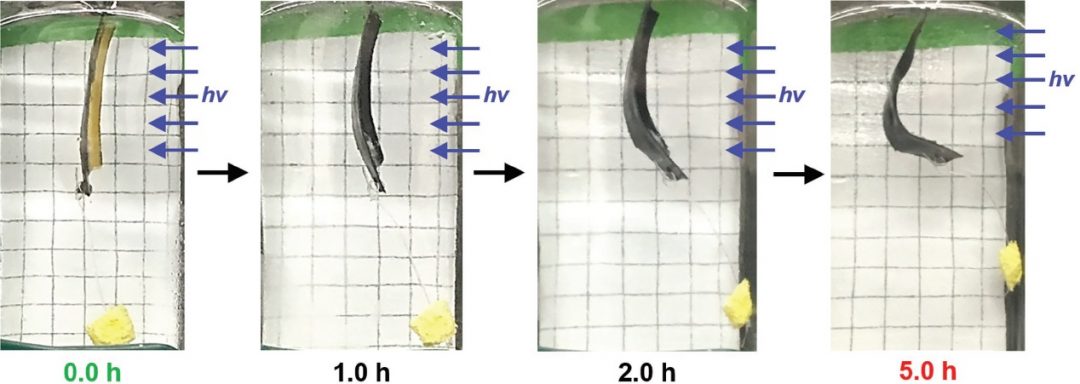Photoinduced chemical reactions within stimuli-responsive materials can be used to adjust their physical shape, leading to actuation. Several mechanisms are possible, one of the most common being an isomerisation of known photoresponsive polymers. A more recently developed mechanism involves the photoinduced, unidirectional motion of molecular motors, which was able to cause a macroscale contraction and expansion of the hydrogel into which it had been incorporated.
This is the real challenge for such actuation studies: being able to generate movement on the macroscale to perform useful work.
Researchers from Washington University, USA, discovered that they could induce actuation in hydrogels using a redox-responsive cascade system instead. When the hydrogel – composed of poly(ethylene glycol), integrated oligoviologen chains, and a crosslinker – is immersed in an aqueous Na2S2O4 solution, the subunits of the chains are reduced to radical viologen cations. This lowers the electrostatic repulsion between the chains and causes them to fold, contracting the hydrogel by up to 35% of its initial volume. The contraction is reversible, with the chains unfolding after immersion in oxygen-rich water.
The same researchers have now taken this system a step further, removing one of its main limitations: the need to immerse the gel in a reducing chemical bath in order to induce actuation. Their new hydrogel composition includes a photoredox catalyst and a sacrificial reductant: blue-light irradiation initiates a photoinduced electron transfer to the viologen subunits. This leads to the same chain-folding actuation mechanism, just with a slightly simpler trigger.
Mechanical strength tests were used to evaluate the robustness of gels with different molar percentages of polyviologen over three contraction/expansion cycles. It was determined that the optimum concentration was around 5 mol%, with larger amounts of polyviologen rendering the hydrogel too brittle, and smaller amounts preventing good contraction.

Artificial molecular muscle demonstration, showing work done upon photoinduced contraction of the hydrogel.
As a proof-of-concept, the researchers constructed an artificial molecular muscle using the 5 mol% sample. The hydrogel was attached to a strip of black electrical tape, and a small weight – a 20.0 mg piece of sponge – was hung from the base. As the gel contracted, the tape was bent and the sponge was lifted upward several centimetres: measurable work on the macroscale.
Check out the details of their work in Macromolecular Rapid Communications.
If you’re studying soft robotics, you may also like to check out these popular recent articles:
Electrically Driven Bio-Inspired Soft Robotics
Engineering Digest – Featuring Soft Robotics, Mechanical Metamaterials, and More
















